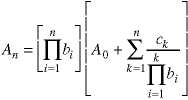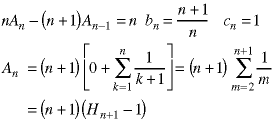
[WPI] [cs2223] [cs2223 text] [News] [Notes] [Recurrence]
The class of first-order, non-homogeneous, linear recurrence relations can usually be solved by means of the summing factor solution, which is closely related to the integrating factor solution for first-order differential equations.
Assume the recurrence relation can be written in this form:

where the bn and cn are functions of n. Here are two examples:

Then the solution is.

Where An is the initial condition. Note that none of the coefficients bn can be zero or the denominator inside the summation becomes zero and the solution may not exist.
If we assume A0=0, the solution to the first recurrence relation above is:

The approximation applies for large values of n.
Assuming, again, assume A0=0, the solution to the second recurrence relation above is:

Note the use of Hn, the Harmonic series, which is discussed in Class 4.
The attached Excel spreadsheet shows that the first few terms of these solutions are correct. A zip versionis attached for those whose browsers experience difficulty when downloading Excel spreadsheets.
![]()
![[WPI Home Page]](../../../images/wpi_logo_small.gif) |